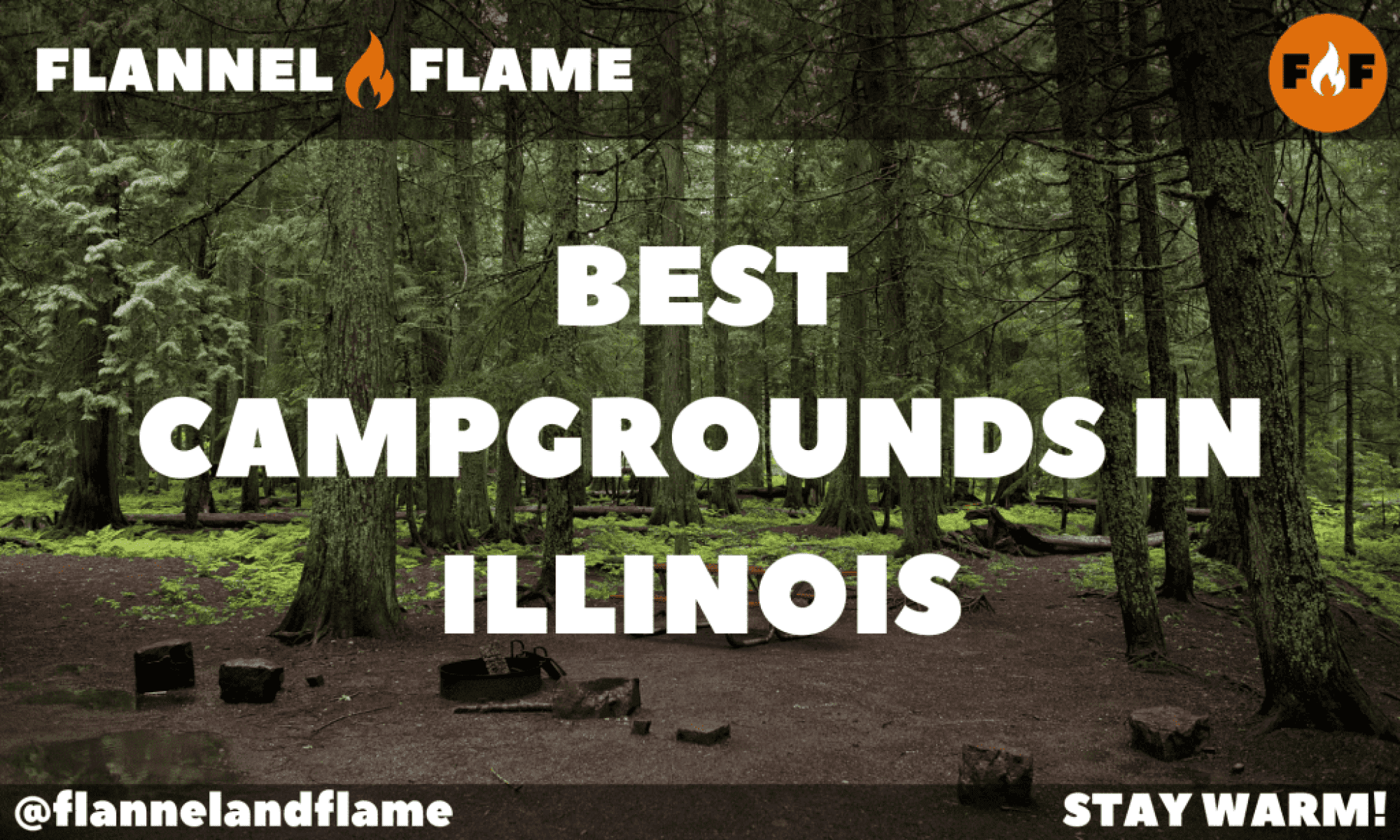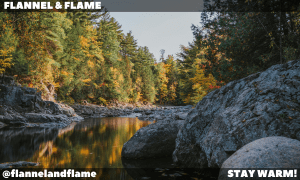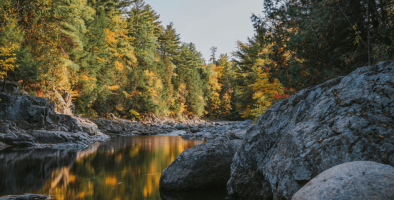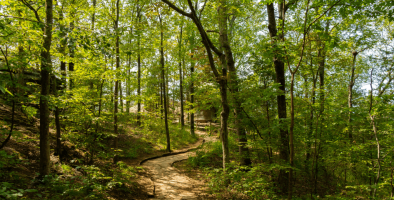Best Campgrounds in Illinois
Beyond Chicago’s iconic skyline and the state’s vast farmlands lies another Illinois—one of hidden canyons, ancient forests, and pristine lakeshores. The Prairie State offers surprisingly diverse camping experiences, from the rolling hills of the Shawnee National Forest in the south to the sandy beaches along Lake Michigan in the north. Illinois campgrounds provide perfect basecamps for exploring limestone bluffs, cypress swamps, and everything in between. Whether you’re seeking family-friendly amenities or secluded wilderness, these exceptional Illinois campgrounds deliver memorable outdoor experiences through all four distinct seasons that paint the landscape in ever-changing colors.
Starved Rock State Park
Number of Campsites: 129
Reservation Website: ReserveAmerica.com
Address: 2678 E 875th Road, Oglesby, IL 61348
Carved by ancient glacial meltwater, Starved Rock State Park stands as Illinois’ crown jewel of natural beauty. The park’s dramatic landscape seems almost out of place in the otherwise flat Midwest—18 glacier-carved canyons cutting deep into sandstone bluffs, each one hiding picturesque waterfalls that transform with the seasons.
The campground sits atop the bluff in a mature oak and hickory forest, where dappled sunlight filters through the leafy canopy during summer months. Sites are arranged in well-organized loops with modern amenities including electrical hookups, hot showers, and a camp store for forgotten essentials. While not secluded, thoughtful spacing and natural barriers provide a sense of privacy between many of the sites.
Mornings in camp begin with the musical chorus of woodland birds—cardinals, chickadees, and woodpeckers announcing the day. The crisp air carries the earthy scent of fallen leaves and sun-warmed pine. Trails lead directly from the campground to the park’s main attractions, with the sound of rushing water guiding hikers toward the hidden canyons.
St. Louis Canyon rewards explorers with a 80-foot waterfall that crashes into a circular pool surrounded by moss-covered walls that seem to glow with their own emerald light. During spring thaws and after heavy summer rains, the falls thunder impressively, while winter transforms them into magnificent ice sculptures—frozen cascades suspended in time.
The elevated pathways along the Illinois River offer spectacular views across the water to Plum Island, where bald eagles soar overhead during winter months. In autumn, these trails become corridors of color as maples and oaks put on a spectacular display of reds, oranges, and golds that reflect in the river below.
Evening brings a different energy to the campground as families gather around fire rings beneath star-filled skies. The relative proximity to Chicago (about 90 minutes) makes Starved Rock an accessible weekend getaway, though its popularity means reservations are essential, particularly during fall color season when the park reaches its scenic peak.
Garden of the Gods Recreation Area
Number of Campsites: 12 primitive sites
Reservation Website: First-come, first-served
Address: Karbers Ridge Road, Herod, IL 62947
Deep in the Shawnee National Forest, where southern Illinois begins to ripple and rise into the ancient Shawnee Hills, Garden of the Gods presents a landscape that seems borrowed from the American West. Massive sandstone formations—sculpted by wind and water over 320 million years—create an otherworldly setting unlike anything else in the Midwest.
The small, primitive campground offers an intimate experience with nature, tucked into a grove of hardwoods just minutes from the park’s main attractions. Sites are rustic but charming, with fire rings and picnic tables being the extent of amenities. No electricity, no showers—just the basics, allowing the natural surroundings to take center stage. What the campground lacks in facilities, it more than makes up for in location and tranquility.
Days begin with soft light filtering through the forest canopy, often accompanied by mist rising from the surrounding valleys that slowly burns away as the sun climbs higher. The campground’s elevated position provides cool breezes even during humid summer months, rustling through the leaves in a continuous natural soundtrack.
A short hike leads to the park’s signature feature—the Observation Trail—where massive sandstone formations with descriptive names like Camel Rock, Monkey Face, and Devil’s Smokestack emerge from the forest floor. These ancient sentinels, sculpted into fantastical shapes, glow golden in the late afternoon light. Balancing rocks seem to defy gravity, while the 1/4-mile trail offers panoramic views across the wilderness area beyond.
For the adventurous, networks of backcountry trails lead deeper into the Shawnee Forest, winding through hidden valleys where deer pause to watch hikers pass. Rock climbers test their skills on challenging faces and boulders, while photographers find endless compositions in the interplay of light, stone, and forest.
As night falls, the campground reveals one of its greatest assets—dark skies largely untouched by light pollution. Stars appear in overwhelming numbers, the Milky Way stretching across the heavens in a brilliant band of light. On clear nights, the conjunction of ancient rocks below and timeless stars above creates a profound sense of perspective.
Mississippi Palisades State Park
Number of Campsites: 241
Reservation Website: ReserveAmerica.com
Address: 16327 IL Route 84, Savanna, IL 61074
Where the mighty Mississippi River carves its path between Illinois and Iowa, limestone bluffs rise dramatically from the water’s edge, creating the impressive landscape of Mississippi Palisades State Park. Native Americans called these bluffs “the land of tall cliffs,” a fitting description for the 2,500-acre park where some cliffs soar 150 feet above the river.
The campground occupies a mostly wooded area set back from the bluff edge, offering sites that range from open and sunny to deeply shaded. The mature forest of oak, maple, and hickory creates natural divisions between many sites, though the campground’s popularity during peak seasons means true seclusion is rare. Modern amenities including electrical hookups and shower buildings provide comfortable camping experiences for families and groups.
Mornings often begin with a misty river view, as fog rises from the Mississippi before being burned away by the climbing sun. Birds dominate the dawn chorus, with distinctive calls of kingfishers, herons, and eagles often heard above the gentle background rustle of the forest and distant barge traffic on the river.
Fifteen miles of hiking trails crisscross the park, leading to spectacular overlooks where the full grandeur of the Mississippi River Valley comes into view. Sentinels Point and Louis Point offer particularly breathtaking vistas across the water to the Iowa shore. Spring brings vibrant wildflowers carpeting the forest floor, while autumn sets the bluffs ablaze with color, the fiery trees contrasting dramatically with the blue waters below.
Rock climbers find paradise among the park’s limestone features, with Twin Sisters and Indian Head providing challenging ascents. For less adventurous visitors, photography blinds positioned throughout the park offer perfect vantage points for capturing wildlife, especially the numerous bald eagles that winter along this stretch of river.
As evening approaches, many campers make their way to the western overlooks where sunsets paint the river and sky in spectacular color. The gradually dying light creates dramatic silhouettes of the limestone palisades against an often technicolor sky before stars begin to appear overhead, completing the day’s natural showcase.
Shabbona Lake State Park
Number of Campsites: 150
Reservation Website: ReserveAmerica.com
Address: 4201 Shabbona Grove Road, Shabbona, IL 60550
Just 70 miles west of Chicago, Shabbona Lake State Recreation Area provides an accessible escape into nature centered around a picturesque 318-acre man-made lake. The campground sits nestled among rolling hills covered with second-growth forest, offering a perfect balance of water activities and woodland exploration.
The campsites spread across several loops, some open and grassy for sun-lovers, others tucked beneath a canopy of maple, oak, and hickory trees providing welcome shade during summer months. Most sites include electrical hookups, picnic tables, and fire rings, while modern shower buildings and a well-stocked camp store add convenience to the outdoor experience. Paved camping pads make setup easy, while thoughtfully designed spacing prevents the feeling of being crowded.
Mornings at Shabbona often begin with lake mist rising above the water’s surface as early-rising anglers quietly launch boats in search of the lake’s famous trophy bass, muskie, and catfish. The still water perfectly mirrors the surrounding trees until gentle breezes create rippling patterns across its surface.
A network of hiking trails circles the lake and ventures into surrounding woodlands, providing opportunities to spot white-tailed deer, wild turkeys, and a variety of songbirds. The 2.5-mile lakeshore trail offers continuous views of the water through changing forest scenes, while prairie restoration areas burst with native wildflowers from late spring through fall, attracting countless butterflies that dance among the blooms.
The lake itself serves as the park’s recreational centerpiece. Boat rentals make water access easy for those without their own craft, while two fishing piers accommodate shore anglers. A swimming beach provides refreshing relief during hot summer days, its golden sand warming quickly in the morning sun as families stake out their spots for the day.
As evening approaches, the campground becomes animated with the flickering light of campfires and the delicious aromas of outdoor cooking. The lake’s western shore offers sublime sunset viewing, with the entire water surface transformed into a canvas of reflected color. Night brings a chorus of frogs and the occasional call of distant owls, creating the perfect soundtrack for stargazing in the relatively dark skies.
Ferne Clyffe State Park
Number of Campsites: 109 total across multiple campgrounds
Reservation Website: ReserveAmerica.com
Address: 90 Goreville Road, Goreville, IL 62939
Tucked into the rolling hills of southern Illinois, Ferne Clyffe State Park reveals a hidden landscape of lush forests, dramatic rock formations, and cascading waterfalls. The park’s name derives from the abundance of ferns that carpet the forest floor and cling to sheer rock walls, creating an almost primeval atmosphere within its sheltered canyons.
The park offers several distinct camping areas, each with its own character. The main campground provides electrical hookups and modern amenities, while the more primitive Backpacker’s Campground offers a truly secluded experience for those willing to hike in. Turkey Ridge Campground caters specifically to equestrian campers with facilities for horses and access to dedicated riding trails.
Morning light filters through the dense canopy of oak, hickory, and maple trees, creating ever-shifting patterns on the forest floor below. The air feels noticeably cooler within the park’s sheltered hollows, carrying the earthy fragrance of moss and rich soil. Birdsong echoes through the trees, occasionally punctuated by the distinctive drumming of pileated woodpeckers working on distant trunks.
The park’s crown jewel—Big Rocky Hollow—features a 100-foot waterfall that cascades dramatically after spring rains or summer storms. The approach through the hollow follows a crystal-clear stream bordered by lush vegetation and massive rock formations. During dry periods, the falls reduce to a gentle trickle, but the amphitheater-like rock shelter at its base remains an awe-inspiring sight with ferns decorating every available crevice.
Miles of interconnected trails offer adventures for every ability level. The easy Round Bluff Nature Trail passes beneath massive rock overhangs where native peoples once sought shelter, while the more challenging Happy Hollow Trail descends into a box canyon with vertical walls rising on three sides. For panoramic views, Hawks’ Cave Trail leads to elevated overlooks across the forested valleys.
Spring brings an explosion of wildflowers including trillium, jack-in-the-pulpit, and colorful orchids that carpet the forest floor. Autumn transforms the canopy into a blaze of color that reflects in still pools along the creek beds. Winter offers its own magic when occasional snow dusts the rock formations and leafless trees reveal dramatic stone features normally hidden by summer foliage.
As darkness falls, the protected valleys create ideal conditions for remarkable star-gazing. The relative distance from major urban areas results in minimal light pollution, allowing the Milky Way to emerge in spectacular detail above the ancient landscape below.
Illinois Beach State Park
Number of Campsites: 244
Reservation Website: ReserveAmerica.com
Address: 1 Lake Front Drive, Zion, IL 60099
Along the shores of Lake Michigan in the northeastern corner of Illinois lies a unique natural treasure—the last remaining beach ridge shoreline left in the state. Illinois Beach State Park stretches for 6.5 miles along the great lake, encompassing 4,160 acres of distinctive coastal habitat where sandy beaches, sweeping dunes, wetlands, and prairie exist in remarkable harmony.
The campground sits nestled among black oak forests just a short walk from the shoreline, offering sites with varying levels of shade and privacy. Most sites include electricity, while modern shower buildings and restroom facilities add comfort to the experience. The campground’s layout follows natural contours, with some loops offering glimpses of Lake Michigan between the trees.
Mornings begin with the distant sound of gentle waves washing ashore and light filtering through the oak canopy. During spring and fall migrations, birdsong reaches impressive volumes as the park serves as a crucial stopover for hundreds of species traveling the Lake Michigan flyway. Early risers often spot white-tailed deer moving silently through the campground’s edges toward the protection of thicker woods for daytime hours.
The park’s most distinctive feature—its expansive shoreline—lies just beyond the campground. Unlike typical Midwestern beaches, Illinois Beach features a complex ecosystem of dunes, swales, marshes, and prairie that provides habitat for remarkable biodiversity. More than 650 plant species have been identified within the park, including some found nowhere else in the state.
Miles of hiking trails wind through these varied ecosystems. The Sand Pond Trail loops through wetlands where herons stalk the shallows and painted turtles bask on fallen logs. The Beach Trail follows the shoreline, where the constant rhythm of Lake Michigan shapes and reshapes the land in an endless natural cycle. During summer, swimming areas provide refreshing relief from heat, while beach walkers search for colorful beach glass and unique stones polished by the lake.
As evening approaches, the western sky often puts on a spectacular show as sunsets paint clouds in brilliant hues that reflect off Lake Michigan’s vast surface. After dark, the distant lights of Chicago and Milwaukee may be visible on clear nights, glimmering like earthbound constellations to the south and north.
The park’s location along Lake Michigan creates distinctive weather patterns, with cooling lake breezes providing natural air conditioning during summer months. During winter, these same conditions can generate impressive lake effect snow that transforms the landscape into a silent white wonderland popular with cross-country skiers and wildlife photographers.
Final Thoughts About Camping in Illinois
From ancient sandstone formations to pristine lakeshores, deep forests to dramatic river bluffs, Illinois offers surprisingly diverse camping experiences that showcase the Prairie State’s natural beauty in all its forms. While each location presents its own unique character, they all provide perfect basecamps for exploring landscapes shaped by glaciers, rivers, and time itself.
These six exceptional campgrounds represent just a sampling of the outdoor adventures waiting across Illinois. The state’s varied geography creates distinct experiences from north to south, with each region offering its own natural and cultural attractions. Whether you’re seeking family-friendly amenities or rugged backcountry experiences, Illinois campgrounds deliver memorable outdoor adventures through all four seasons.
Remember to reserve sites well in advance for popular parks, particularly during peak fall color season when the state’s natural beauty reaches its zenith. Pack for changeable Midwestern weather, and prepare to discover an Illinois far removed from the cornfields and cityscapes that dominate popular perceptions of this surprisingly diverse state.
Other States to Explore
More from Flannel & Flame…
- Mexican Bean SaladBold, zesty, and bursting with color, this Mexican Bean Salad is a side dish that brings the flavor anywhere you roam. A hearty mix of black, kidney, and cannellini beans comes together with crisp bell peppers, sweet corn, and red onion, all tossed in a citrusy vinaigrette loaded with fresh cilantro and just the right… Read more: Mexican Bean Salad
- Cheesy PotatoesGolden, gooey, and loaded with flavor, these Dutch Oven Cheesy Potatoes are a campfire favorite that never disappoints. Tender hash browns are layered with melted cheese, savory seasonings, and just the right amount of smoky goodness from the fire. Baked slow and steady in a Dutch oven, this comforting side dish is perfect alongside grilled… Read more: Cheesy Potatoes
- Alternatives to S’Mores: Sweet Twists and Campfire Treats You’ll CraveThere’s something undeniably magical about a gooey s’more melting between your fingers under a starlit sky. The way the chocolate gets just soft enough, the marshmallow smolders to a golden hue (or charred to a crisp, if that’s your thing), and the graham crackers give that perfect crunch — it’s the taste of summer, nostalgia,… Read more: Alternatives to S’Mores: Sweet Twists and Campfire Treats You’ll Crave
- Best Hiking in New YorkWilderness, waterfalls, and wonder from the Catskills to the Adirondacks New York might be synonymous with skyscrapers, yellow cabs, and a certain iconic skyline—but trust me, beyond the hustle of the city, the Empire State hides some of the most jaw-dropping trails in the Northeast. We’re talking misty mountaintops, mossy forests, gorges carved by ancient… Read more: Best Hiking in New York








